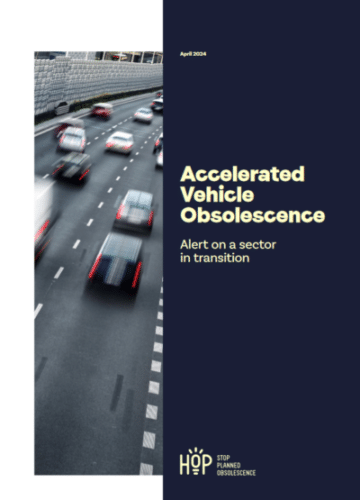It is necessary to reduce the health and environmental footprint of the road sector. This must be achieved above all through sobriety measures and by switching to other, less polluting means of transport. But the automobile sector is undergoing significant changes, as by 2050 there should be no more combustion-powered vehicles on the road.This change is leading to the accelerated obsolescence of the current fleet of individual vehicles, and the gradual electrification of the vehicle fleet.
The lifespan of vehicles is currently estimated at 19 years, but the regulations shaking up the automobile sector are speeding up their obsolescence. According to a Senate report, at least 34% of the French car fleet will be excluded from Low Emission Zones (LEZ) by 2025. While many people are discriminated against by this regulatory obsolescence, it may seem explained from a health and environmental point of view. The transition goes along with a number of aid measures (conversion bonuses, ecological bonuses, electric leasing, etc.). However, they only partially address the issues, as motorists are faced with complex economic and ecological trade-offs in a market dominated by second-hand cars (nearly 75%). The question remains, however, what will become of these vehicles, which are polluting but still functional.
The vehicle’s lifespan is currently estimated at 19 years.
To replace older vehicles, public policies are inciting the purchase of new electric vehicles. In Europe and France, the current political choice is to electrify the vehicle fleet by introducing standards and economic incentives (such as the Corporate Average Fuel Economy [CAFE] regulation). Since new combustion and hybrid vehicles will no longer be allowed on the European market from 2035, almost all manufacturers are now offering a range of electric cars. When in use, these cars consume electricity, which at first glance is less expensive and less polluting than hydrocarbons in Europe. Therefore,
they are an asset in the fight against global warming. However, they are more expensive to produce, and their manufacture has a greater carbon impact than the production of combustion-powered cars, because of the battery. Furthermore, the production of electric vehicles involves other sorts of impact that need to be taken into account when assessing the sector’s total ecological footprint (eutrophication, natural resources, etc.). So, to promote sustainable mobility, the durability and repairability of electric vehicles are a prerequisite of the transition.
In this report, the authors highlight numerous flaws in the well-oiled machinery of the circular economy, historically developed in the automobile sector. They identify three major issues that are critical to the sustainability of modern vehicles.
The lifespan of electric vehicles is at risk.
Despite the presumable batteries’ endurance, there is currently no framework for their durability, nor sufficient guarantees of reliability for consumers. Repairability is made very complex, if not impossible, by the difficulties of disassembly (use of resin, foam, irreparability of the modules, etc.).
Furthermore, in order to reduce production costs, a number of manufacturers are moving towards design techniques that make repair economically, if not technically, impossible. Another striking example is giga-casting, an industrial practice that involves molding a large number of car parts from a single block, which could result in a large part of the vehicle having to be discarded and replaced after an impact. For now, the risk of “giga-waste” that this entail affects only a few electric car models, but HOP fears that this practice will become widespread. Generally, the sector is facing problems related to the dismantlability of vehicles, the access to spare parts and components, and the reduction in after-sales services by some manufacturers. The risk of having a rise of “disposable cars” is real. The new routes taken by some manufacturers, which prioritize lower production costs to the detriment of vehicle repairability, must not become the norm.
Finally, the growing presence of on-board electronics and software, which make connected vehicles look like “smartphones on wheels”, increases the risk of software obsolescence and makes repairs outside manufacturers’ approved networks more complex (for example, because of “serialization” practices, unavailability of some electronic components, blocked access to essential data for diagnosis or repair, etc.).
Possibly exorbitant repair costs (directly for customers or for insurance companies); hasty renewal of the vehicle; new “hidden” costs at the time of purchase linked to software updates; services or applications, after-sales service with little or no
availability, etc. The consequences of these practices affect consumers, who have no grasp of the total cost of owning a vehicle at the time of purchase. The economic players making up the circular economy ecosystem could also be affected (repair,
reconditioning, second-hand market, etc.). In some respects, incumbent European car manufacturers could be seen as victims of these practices. At issue is their fierce competitiveness in the face of electric vehicles sold at attractive prices by a handful
of American or Chinese competitors, who are dragging quality down.
As the experts interviewed for this study have pointed out, the automobile industry is a long-term business. However, for HOP, this should not be synonymous with inertia or inaction in the face of the worrying signs of an unsustainable trajectory. What we need to do now is laying the foundations for good practice in the circular economy of the electric car fleet, which is set to replace combustion engines, in order to combine lower CO2 emissions, respect for consumers and responsible production.
The association has put forward seven recommendations for public decision-makers (particularly in Europe), to guarantee the sustainability and repairability of future combustion and electric vehicles.
Among these, HOP suggests:
- introducing repairability guarantees for batteries;
- imposing repairability standards: parts that can
be dismantled and are available for at least 20
years; - fighting the threat of software obsolescence: ban
software locks that prevent parts from being re-
paired/reused, and maintain software availability
for at least 20 years



